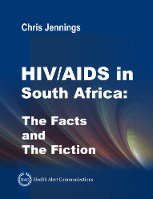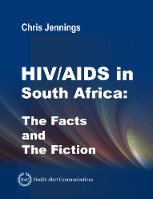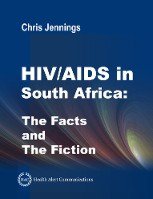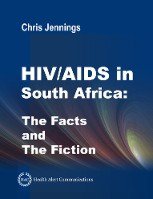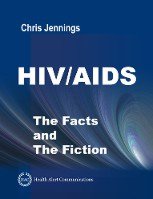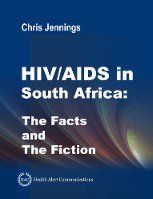HIV/AIDS in South Africa — The Facts and The Fiction
Winner of the Will Solimene Award for Excellence in Medical Communication
from the American Medical Writers Association (AMWA)
“Jennings provides an interesting and well-presented statistical summary that will leave readers questioning the validity of internationally-approved estimates.”
Anna Rabin, East Africa Analyst
Think Africa Press
An Analysis of South African HIV/AIDS Statistics comparing Death Counts, Surveillance Data, and Modeled Estimates
The author, Chris Jennings (Harvard, B.A., Biology 1976), excels at writing scientific books that fulfill the needs of professionals while rendering the science accessible to the average reader.
His prior book, Understanding and Preventing AIDS: A Book for Everyone, was favorably reviewed by the New England Journal of Medicine and adopted for staff education by Massachusetts General Hospital (the hospital affiliated with Harvard Medical School); the U.S. Department of Health and Human Services (HHS); the National Institutes of Allergy and Infectious Diseases (NIAID); Walter Reed Army Medical Institute; sold in medical bookstores; purchased by innumerable city and state health agencies; and utilized as a textbook at colleges, nursing schools, and public health schools.
Order from Amazon or your favorite Bookstore!
US$ 14.95
Contents: 120 pages, 20 tables, several side boxes and 240 references
Few people realize that the familiar HIV/AIDS global statistics are actually estimates. For example,UNAIDS estimated that the Republic of South Africa had 350,000 HIV/AIDS deaths in 2007. However, when the Republic of South Africa tabulated all death certificates for 2007, only 13,521 were attributed to HIV/AIDS.
In the same year:
- 76,761 died from tuberculosis
- 49,722 died from pneumonia
- 37,398 died from intestinal infections
Such discrepancies between UNAIDS estimates and actual death counts are rarely reported. The familiar HIV/AIDS estimates, generated by computers at UNAIDS and the World Health Organization (WHO), are pasted into maps and widely circulated by medical, scientific and public media. Unfortunately, these hyperbolic estimates are widely accepted as absolute fact by the public and professionals alike.
By 2009, an estimated 900,000 South Africans were receiving rather toxic anti-HIV medications, the majority of whom probably lacked HIV infection – while other curable diseases likely went untreated and/or undiagnosed.
“HIV/AIDS Statistics generated by computers state that The Republic of South Africa has the largest HIV/AIDS epidemic in the world.”
The Republic of South Africa stands as the exemplar of these discrepancies between computer estimates and empirical surveillance data and death counts. South Africa is reputed to have the world’s largest AIDS epidemic with an estimated 5.6 million people living with HIV/AIDS (PLWH) in 2008. Such PLWH estimates and the related estimates of death counts are highly questionable.
Unfortunately, the health authorities in the Republic of South Africa grant more validity to the computer-generated estimates than to their own empirical death counts.
HIV/AIDS in South Africa — The Facts and the Fiction discusses why these modeled estimates and the HIV seroprevalence surveys upon which they are based are implausible. It describes common misunderstandings of HIV infection and HIV antibody testing that contribute to poor modeling outcomes.
In the Summer of 1985, when the United States had over 10,000 AIDS cases, the Republic of South Africa had 21 only AIDS cases.
South African HIV/AIDS Statistics – Valid & Empirical
Fully referenced with footnotes, HIV/AIDS in South Africa — The Facts and the Fiction is unique because it presents actual surveillance data and actual death count data. The book provides direct comparisons of these empirical data sets with the questionable estimates generated by the WHO and UNAIDS computers.
For example, HIV/AIDS in South Africa — The Facts and the Fiction presents and compares raw numerical data on:
- empirically recorded HIV/AIDS deaths in the Republic of South Africa; and
- empirical AIDS case detection by disease surveillance systems in the Republic of South Africa
These empirical death counts and surveillance data are compared with:
- UNAIDS/WHO computer estimates for AIDS deaths in the Republic of South Africa; and
- UNAIDS/WHO computer estimates for the number of people living with HIV/AIDS (PLWH) in the Republic of South Africa
In addition, these empirical and estimated South African HIV/AIDS statistics are directly compared with:
- the empirical HIV/AIDS statistics of the United States; and
- the “empirical” (i.e., estimated) HIV/AIDS statistics for all of Africa
In doing so, HIV/AIDS in South Africa – The Facts and the Fiction places the South African HIV/AIDS statistics into an appropriate epidemiological context relative to HIV/AIDS reporting in the First World.
Overall, these data span from 1981 to 2009.
Moreover, the book juxtaposes the empirical data and computer estimates into appropriate context relative to the medical and scientific nature of HIV infection, HIV disease progression, and the known rates of HIV transmission during heterosexual intercourse (the purportedly decimating African HIV/AIDS epidemic is supposedly driven by heterosexual sex). Altogether, these data explain why the hyperbolic computer estimates of HIV seroprevalence and death rates are far beyond the range of biological reality.
In late 1996, when the United States had over 580,000 AIDS cases, the Republic of South Africa had a total of 13,000 AIDS cases. Two years later, UNAIDS claimed that 140,000 people in South Africa had died of AIDS in 1997 alone.
South African HIV/AIDS Statistics generated by UNAIDS/WHO are Entirely Implausible
Collectively, the empirical data presented by HIV/AIDS in South Africa – The Facts and the Fiction reconfigure the statistical scenario for HIV/AIDS in South Africa (and, by association, in many other indigent, tropical settings).
These new data indicate that past and current UNAIDS estimates for HIV/AIDS deaths in the Republic of South Africa could be overestimated by two orders of magnitude. Furthermore, the estimates for the number of people living with HIV/AIDS in sub-Saharan Africa were likely inflated in an excessive fashion because WHO estimates from 1993 to 2000 were consistently 25 – 30 times the number of reported cases. The majority of “reported cases” during this time period were based on AIDS diagnoses per the WHO Provisional Surveillance Definition which was based on clinical symptoms in absence of any laboratory testing.
HIV/AIDS in South Africa — The Facts and the Fiction is adjuvant to the primary book: HIV/AIDS – The Facts and the Fiction. HIV/AIDS in South Africa – The Facts and the Fiction provides numerical substantiation to some of the descriptions and assertions presented in HIV/AIDS – The Facts and the Fiction.
HIV/AIDS — The Facts and the Fiction and HIV/AIDS in South Africa — The Facts and the Fiction are seminal works granting new comprehension. Both books have powerful implications for HIV/AIDS funding, research prerogatives, strategies for diagnosis, and global health care interventions.
Be sure to examine the larger, primary book HIV/AIDS — The Facts and The Fiction
| Title: | HIV/AIDS in South Africa — The Facts and The Fiction |
| Author: | Chris Jennings |
| Publisher: | Health Alert Communications |
| ISBN-10: | 0-936571-08-X |
| ISBN-13: | 978-0-936571-08-9 |
| Price: | US$ 14.95 |
| Page Count: | 120 pages |
| Contents: | Table of Contents |
